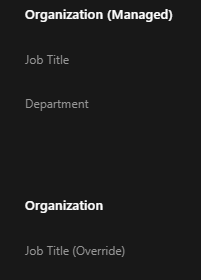Thanks everyone, I appreciate the discourse.
I was able to work around this by setting up web interfaces with a separate section and using renamed extensionAttributes and powershell.
Basically, on the web interface, I created a layout for the group of users who need to ovverride the property.
On the back end, I used extensionAttribute1 named "Job Title (Override)" with a condition that if X updates that field, to then run a powershell script that basically runs Set-ADUser. This bypasses the global properties.


and on the Web Interface side I created "Organization (Managed)" which is the global property and "Organization" containing "Job Title (Override) to bypass the global properties.

Hope this helps everyone in the future!